#play analysis
Text
Analyzing Nick Dear's Frankenstein (and why we should move on to better play adaptations)
Alrighty y'all, its the long-awaited Nick Dear Frankenstein analysis post! This post is focusing specifically on Dear's characterization of the Creature, and why it negatively affects the play overall (plus some adaption theory added in for funsies). For additional context, I am an MFA candidate studying theatre, and I did this research and the accompanying slides for a project in my graduate-level theatrical criticism class. Basically this post is the text version of that presentation, with some of the slides included, and the fluff trimmed. There is a fair bit of academic jargon in here, but I tried to make it as accessible as possible!
And with all of that out of the way, the Nick Dear Frankenstein deep dive is under the cut! (And citations at the end.)
CW: Discussions of violence and SA.
Before I get into the script itself (which if you are interested in reading it, a PDF version is easily found on google), I want to introduce a fun adaptation theory which is specific to studying Frankenstein, called "Frankenstein Complex Theory." This theory comes from Dennis R. Cutchins and Dennis R. Perry in the introduction section to "Adapting Frankenstein: The Monster's Eternal Lives in Popular Culture." (A fantastic read that I recommend to anyone if your school or local library has it in circulation.) This introduction introduces the "complex" theory, as well as some really awesome ideas that get used and referenced by all of the authors included in the book.

Basically Cutchins and Perry assert that traditional adaptation theory is simple not enough to properly study Frankenstein and it's innumerable adaptations. One might also assert that Frankenstein itself is an adaptation, Mary Shelley published multiple editions of her story, and one could argue that the original story is an adaptation of other stories like "Paradise Lost." Linda Hutcheon, another academic in the field of adaptation studies who also wrote a fantastic book (cited at the end), talks about this idea of "palimpsestuous Intertextuality." I want to first argue here that the original text of Frankenstein and its adaptations (the "myth" of Frankenstein) are palimpsestuous.
And when I say the "myth" of Frankenstein is "palimpsestuous," its basically just saying that the "myth" (tall green guy with bolts in his neck who is mostly non-verbal, going around killing people mostly without rhyme or reason) is the predominate cultural narrative of Frankenstein's monster, rather than how he actually is in the book. All of the cultural ideas of what Frankenstein's monster is are this giant network which interweaves with itself, references and builds off itself, and constantly creates new things from these connections. The book and it's adaptations are not in hierarchy, one is not implicitly better or more important than another, they all work together to create our cultural narrative of Frankenstein's monster. Thus, palimpsestuous Intertextuality.
But what is this "Complex" theory I mentioned earlier, and what does it have to do with Nick Dear? Well, here is a helpful diagram!
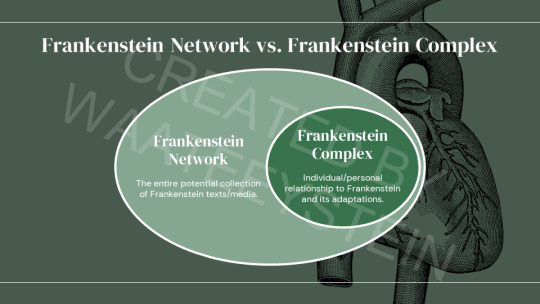
Essentially, every piece of Frankenstein media every created, including Mary Shelley's original novel, are all part of the "Frankenstein Network." The complex, however, is personal, it includes anything from that network that you have personally consumed. Some people have a wider complex than others, but nonetheless, most of us have some kind of Frankenstein Complex (if you're this far in the post I'm assuming you have one lol.) I think Cutchins and Perry really popped off when they created this theory, its a fantastic way of studying/teaching adaptation.
But onto Nick Dear. Why did I just spend so much time covering adaptation theory and teaching you all a bunch of academic jargon? Well firstly, I spent a lot of time on that research for class and I wanted to share. But secondly and more importantly, my thesis for this entire post is that Nick Dear, whose goal with his play was to create an adaptation which humanized the Creature and sticks very close to the novel, created something that was unintentionally more a product of his personal complex and the palimpsestuous "myth" of Frankenstein's monster. He wrote a play that deeply mischaracterizes the Creature, and in turn uses violence and SA for shock value rather than substance.
And maybe this is a bold claim, but I think comparing the plot of the novel (from the creature's point of view) and the plot of Dear's play is a good place to start. And for your visual reference, I created a plot diagram for both so that we can compare the two side-by-side. (Thanks Freytag lol.)
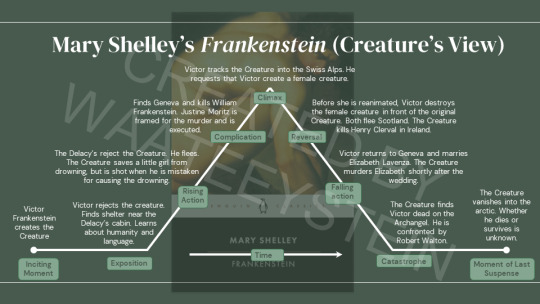
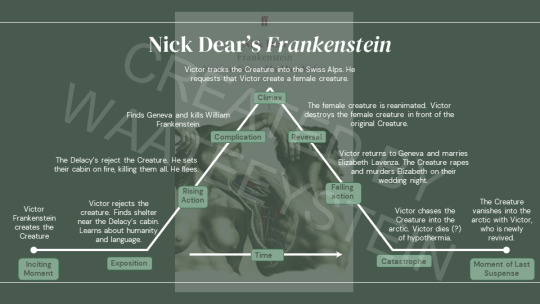
The first thing we can notice about comparing the overall plot structure is that they are indeed, very similar. And this tends to be most people's reactions to seeing this play. That compared to most other Frankenstein media, it is super faithful to the book in terms of setting and characters and hitting important plot points. And I too want to praise Dear for that. I think he was extremely smart about what characters he chose to cut or combine, and the plot points he chose to include. I also personally love that despite the cutting of Walton's character, Victor and the Creature still visit the arctic at the end of the play. Dear made so many great choices with his play, but ends up squandering it his mischaracterization of the Creature.
But how is he mischaracterizing the Creature? Well first, lets look at how Shelley characterizes him in the book, specifically in terms of violence. I argue, that anytime the Creature kills someone in the book, it is a mostly equal/proportionate reaction to the violence done against him. His first murder his killing William, and the subsequent execution of Justine after he frames her for William's murder. All of this comes after Victor's initial rejection of the Creature, and rejection by multiple villages, the DeLacey's and the young drowning girl and her father. Killing William and Justine was his first retribution after all of the rejection and violence against him, which was initiated by Victor creating him and rejecting him in the first place. And this is his only planned revenge at that point, his next move was demanding that Victor create a female creature for him, with the plan to flee and live a peaceful life in South America (whether he actually meant what he said is up to interpretation.) His next murders only come after Victor destroys the unfished female creature. This is when the Creature kills Henry and then Elizabeth. Elizabeth (and arguably Henry) are Victor's partners, and the people he most personally loves. Killing them is direct retribution for Victor destroying the female Creature, who was supposed to be (at least from the Creature's perspective) the Creature's romantic partner. All of the Creature's direct murders are direct mirrors to Victor's transgressions against the Creature. William is killed for the initial rejection and subsequent exiling from society, Henry and Elizabeth are killed for the destruction of his future romantic partner.
Dear takes a different approach in adapting these murders. In his play, the Creature's first murder is not William, but is actually the DeLacey's. After being personally tutored by Father DeLacey for a significant amount of time, the eventual and fated meeting with Felix and Agatha arrives and the creature is rejected by them. Instead of going straight to Geneva, as he does in the novel, he first sets fire to the DeLacey's cabin, killing the entire family inside. To me, this feels like the first instance of spectacle and shock over actual substance. In both Shelley's novel and Dear's play, as the creature learns about humanity and war, he clearly has a distaste for violence and killing. And because of this, I don't understand why the Creature has such an extreme reaction to the DeLacey's, especially in this version where Father DeLacey shows him so much direct kindness, and it is Felix and Agatha specifically who reject him. Why would the Creature decide to kill them all? If Dear wanted to add additional deaths, why not just kill Felix and Agatha and spare Father DeLacey because of his previous kindness? This violence, to me, feels undeserved and does not mirror the violence done against him by this family. From a staging perspective, the visual of the house burning is actually a very impressive collaboration between the set and lighting designers on the giant stage of the National Theatre. But I question why this moment needs to be here, when the rest of the play and it's staging in the premier production already has so much beauty and shock and spectacle. This is also the first moment where I find the Creature unsympathetic, because this action seems overly extreme as a response.
After this moment, the murder of William is different but not too dissimilar in tone to the novel. At it's heart, it is still the Creature's first direct revenge against Victor. After this, our next big departure from the novel is when the female creature is fully brought to life, different to the novel where she is never fully given life. Victor killing her after she has been able to briefly live is a more extreme measure on Victor's part too, which by my own argument, may warrant a more extreme reaction from the Creature. And to be absolutely clear, Victor simply kills/dismantles her, and nothing more. As for the creature's reaction, Henry is a cut character in this adaptation, so we obviously don't see his death. Instead, the Creature kills Elizabeth, but in this version, not only does the creature kill her, he also r*pes her. This is my biggest point of contention with the play. To me, the subtext in Dear's version is that the Creature views both Elizabeth and the Female Creature as some kind of property, and when his property (the female Creature) is taken away by Victor, he takes Victor's property (Elizabeth) away too. Right before her death in the play, the Creature and Elizabeth actually have a really touching conversation, and they seem to genuinely bond. And so when the Creature eventually kills her afterwards, him r*ping her comes completely out of left field. The only explanation to me, is that despite empathizing with her, the Creature ultimately still views her as Victor's property, and needed to take her away from Victor in a way that was more than just taking her life from him. And honestly, it's a really gross interpretation of these characters. And I want to be very clear that I know depiction is not endorsement, and that I also believe there is a time and a place for depicting SA on stage, but this play was not the time nor the place. The creature simply killing Elizabeth is enough to get the point across, the SA seems to have been added for pure shock value, and again, spectacle. One could argue that this action done by the creature is part of his sexual awakening, just as he learns about other aspects of humanity. But again I believe this is not justified by the text of the play, and is written for pure shock value at the expense of another character, specifically a woman. I would call this misogynistic.
And these extreme reactions from the Creature in Dear's play seem to create this hyper-masculinized version of the character and the story. And I think that is a shame considering the original story was written by a woman, and Mary Shelley did a fantastic job of writing a story where the men can exist across a spectrum of masculinity, without needing to be this stereotyped version of hypermasculinity with a desire for sexual vengeance. I mean, Victor creating the Creature is a pretty clear metaphor for motherhood/parenthood, especially considering Shelley's experience with motherhood and the loss of her children and her own mother. And not to say that a cis man isn't capable of writing an authentic adaptation of a woman's story, but here, I think Nick Dear missed the mark, especially in regards to Elizabeth's death and his depiction of Creature/masculinity.
And I don't want to boil this down to, "Nick Dear is a man and therefore his adaption is automatically bad." Because I don't think that's the case, and I think that's an unfair assumption to make. What I do think, is that despite trying to make an adaptation that strove to humanize the Creature better than most other adaptations, Dear instead created an adaptation that fell into the overly-violent monster tropes of the greater Frankenstein Network of adaptations. In essence, Dear may have unintentionally become a product of his own "complex." And unfortunately, that subconscious influence may be partially why we get this interpretation of the Creature, and the unnecessary shock factors added into the story.
So where do we go from here? Chances are, if you see a theatre company putting on a production of Frankenstein, it's probably the Nick Dear version. This was the case for me last October when I accidentally attended a production of this script at a professional theatre company back home in Florida. My hope is that one day we can move on from this script, and find a Frankenstein play adaptation that humanizes the Creature in a way that most audiences (who probably have not read the book) are unfamiliar with, while also not resorting to shock value that dehumanizes the women in the story. My homework for myself beyond this research project, is to read more Frankenstein play adaptations, and specifically ones that are not written by cis men. I think the experiences of women, trans people and disabled people (or obviously any intersection of these communities and identities) could really lend themselves to new and exciting interpretations of the script that bring broader perspectives into context. If you have any suggestions of Frankenstein plays or playwrights who have written Frankenstein plays, I would love to check them out! I also suggest giving the National Theatre world premier pro-shot of Nick Dear's Frankenstein a watch, purely just for the design of the show. Costumes, set, sound and lighting are all really spectacular, and I would love to do an analysis of that aspect of the show one day.
Obviously there was a lot about this show I didn't cover (Cumberbatch, I know), I just wanted to cover the characterization of the Creature at a textual level, because to me that is the most glaring issue with this play. Please let me know your thoughts, and thanks for reading if you got this far!
Citations (I didn't do a great job of referencing these in-text, but all of these sources are great and I highly recommend checking them out!)
Cutchins, Dennis R, and Dennis R Perry. “Introduction- The Frankenstein Complex: When the text is more than a text.” Adapting Frankenstein: The Monster’s Eternal Lives in Popular Culture, Manchester University Press, Manchester, 2018, pp. 1–19.
Dear, Nick, and Mary Wollstonecraft Shelley. Frankenstein: Based on the Novel by Mary Shelley. Faber and Faber, 2011.
Hutcheon, Linda. “Beginning to Theorize Adaptation: What? Who? Why? How? Where? When?” A Theory of Adaptation, Routledge, New York, New York, 2006, pp. 1–32.
Jones, Kelly. “Adaptations of ‘liveness’ in theatrical representations of Mary Shelley’s Frankenstein.” Adapting Frankenstein: The Monster’s Eternal Lives in Popular Culture, Manchester University Press, Manchester, 2018, pp. 316–334.
Pfeiffer, Lee. “Frankenstein: Film by Whale [1931].” Encyclopædia Britannica, Encyclopædia Britannica, inc., 24 Nov. 2023, www.britannica.com/topic/Frankenstein-film-by-Whale.
Shelley, Mary. Frankenstein; or, The Modern Prometheus. 1818.
Shelley, Mary. Frankenstein; or, The Modern Prometheus. 1831.
#please be nice in the replys!#I hope you all enjoyed this little read#I spent a day writing this instead of doing my actual time sensitive work#frankenstein#frankenstein or the modern prometheus#victor frankenstein#frankenstein monster#mary shelley#nick dear#nick dear frankenstein#script analysis#play analysis#Frankenstein play#waateeystein speaks#waateeystein reviews
13 notes
·
View notes
Text
We must make the assumption that in the world of the play there are no accidents. Nothing occurs “by chance,” not even chance. In that case, nothing in the play is without significance. Correspondingly, the play asks us to focus upon it a total awareness, to bring our attention and curiosity without the censorship of selective interpretation, “good taste,” or “correct form.” Before making judgments, we must ask questions. This is the deepest meaning of the idea, often-repeated but little understood, that the study of art shows us how to live.
—Elinor Fuchs, “EF’s Visit to a Small Planet: Some Questions to Ask a Play” (x)
#dramaturgy#words to live by!#media literacy 101 I daresay!#elinor fuchs#theatre#play analysis#playwriting#visit to a small planet#ef’s visit to a small planet#a visit to a small planet
86 notes
·
View notes
Text
Play: The Elephant Man
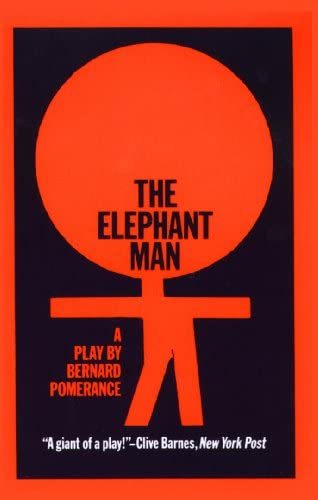
Playwright: Bernard Pomerance
Genre: Historical Fiction, Drama
Date Published: Nov 7, 1977
Original Language: English
Date Read: 1/6/2023
Themes: disability, pity, deformity, kindness
------ below this line may contain spoilers ------
Quotes:
Notes:
• I've just reached the end of scene 10 where Merrick meets Mrs. Kendal. It concludes with the stage direction: 'As lights fade Merrick sobs soundlessly, uncontrollably.' I had to pause my reading. There is a gut-wrenching feeling to even begin to imagine his thoughts.
• There is a note before the play by the playwright about not attempting to replicate his features, rather having the actor contort occasionally. I'm curious how they performed speech for Merrick. There is something to be considered about having someone perform the role with no attempt at contorting or altering their speech, in a way forcing the audience to perceive him in a way he never was in life; forcing consideration and compassion that are so often withheld from the disabled and "ugly".
• I find in many stories about disabled people, there is a sort of hero made of one person who believes that the protagonist is human, is intelligent. Part of why the moment of Merrick crying, of hearing him speak of never having the opportunity to bathe regularly, is so profound is that it strips away that hero and forces the audience to contend with the humanity of a person they would much more eagerly ignore.
• Scene 12 brings an obviousness to something that I've found so insistently important in storytelling: 'he's like me'. I know it to be a personal misunderstanding of the world, but I have such a strong hope that if only people could understand one another they would not be so cruel.
•Reread scene 16 after.
• I do adore this play. Will be keeping for my bookshelf.
0 notes
Text
aang and sokka have by far the most underrated dynamic in atla. they’re very cute and silly together, but they’re also insane. like, aang’s central tension concerns refusing to let his values be shaped by war and the imperialist logic of his oppressors, whereas sokka’s entire value system has been defined by war, by his experience as a colonized subject. in many ways, the ultimate tragedy of aang’s character, that he may become too cynical to appreciate his cultural values of joy, friendship, freedom, harmony, and peace, is the tragedy that he might someday become what sokka already is.
if aang is a force for good in sokka’s life, showing him how to play, to appreciate living in the moment and connecting with others, then sokka is quite literally a corrupting influence. “there, that’s how it’s done,” he says, and you know he’s not just posturing, because you’ve already seen him kill people before without remorse. sokka is aang’s big brother, his friend, his protector. he plays his games, makes him laugh, shows him kindness and undying loyalty. but he is also everything that aang must constantly strive to never become. he is a ruthless tactician, a hyperlogical cynic, a killer.
sokka would do anything to survive and protect his loved ones against the cruelty of the world. so he chastises aang for refusing to kill, for being soft and idealistic. he in fact almost kills aang after he accidentally hurts katara. while aang can never let himself sink into despair, to adopt the colonial mindset of his oppressors, to close off his heart to hope and feeling, sokka already has. yes, aang shows him joy and friendship and the potential for freedom, but in truth, it’s too late for him. and perhaps if katara cannot retrieve her brother’s humanity, his very soul, from the hollow shell of who he has since become, she has a second chance now, with aang.
#i have an even longer post about this in my drafts if you can believe it#but like. they’re so crazzyyyy#real ones know the best aang&sokka episodes are the deserter the siege of the north the serpents pass (!!!!!!!!) and sozins comet#aang&sokka#aang#sokka#katara&sokka#aang&katara#analysis#god 😭😭#the way aang represents who she wishes sokka COULD be just breaks my heart#SHE JUST WANTS A FRIEND SHE CAN PLAY WITH!!!!!!#fucicuccuucucjkkkk !!!
810 notes
·
View notes
Text
Do you think it bothers Dust that Killer doesn't seem to have any remorse for doing the same things that haunt him in a very literal way? Do you think it bothers Killer that Dust pretends not to feel anything when he's lost the luxury of feeling? Do you think it bothers Horror to hear that Cross was raised with his Alphys like a sister when his betrayed him? Do you think it bothers Cross that Horror is part of the gang when he still has an au and people to go back to, where Cross feels like he'll never have his again? Do you think Nightmare gets them all happy meals when they've been good?
#UTDR#UTMV#Nightmare sans#Bad sanses#I'm not tagging everybody for this because I turned it silly#It was a lil bit real analysis I just can't be serious for too long or I'll die#I just wonder about potential tension in the gang#And whether or not they all get happy meal toys to play with so Nightmare can have peace for an hour
534 notes
·
View notes
Text
God that scene in the last episode was just…
The way Charlie physically closes himself off and Nick sits at his level and gently pulls him back open again
The way Nick literally holds Charlie’s hand through the conversation
The way Charlie allows himself to trust Nick
The way Nick looks so heartbroken that anybody made Charlie feel bad about himself
The way Charlie makes the decision to tell Nick about his SH
The way Nick realizes there’s even more going on than just Charlie’s ED and braces himself to hear it
The way Charlie allows himself to admit his feelings and acknowledge that he doesn’t deserve to feel like that anymore
The way Nick can’t help but hug him
The way Charlie grabs him back and buries his face in Nick’s neck
The way Nick is trying not to cry/be strong for Charlie
The way Nick’s head falls in relief when Charlie said he doesn’t hurt himself anymore
The way Nick won’t allow Charlie to be sorry for this
The way Nick doesn’t put him down or tell him not to do it again, but instead makes Charlie promise to tell him if it gets that bad again
The way Charlie still thinks he’s a burden
The way Nick looks so sad that Charlie would think that of himself
The way Nick gently reassures him that he could never see Charlie as broken or a burden
The way Nick is showing how strong he thinks Charlie is
The way Nick wants to be Charlie’s rock because that’s what Charlie is to him
The way Nick is struggling not to cry
The way Charlie finally accepts that Nick really just wants to help him
The way Nick cradles Charlie’s face
The way it looks like he’s going in for a kiss but is actually going to the forehead for the most tender kiss
The way he immediately goes to rest their foreheads together, just exuding ultimate comfort
The way he goes in for a sweet kiss
The way he’s almost ready to say “I love you” but is interrupted
The way he knows it’s not the right moment
The way Charlie knows anyway
The way Charlie looks like he can’t believe any of this is happening to him, that it’s real, that someone loves him
The long, slow, sweet kiss goodbye
The way neither of them want to leave each other
The way Charlie lingers in the driveway
The way Nick takes a deep breath and lets himself really feel everything once Charlie’s gone
The way Charlie is ready to say “I love you” back
Joe and Kit acted their asses off for this and I’m so so proud of them
#I did not mean for this to be a play by play analysis#it got away from me#heartstopper#heartstopper spoilers#heartstopper netflix#heartstopper netflix spoilers#heartstopper s2#heartstopper season 2#heartstopper series#heartstopper nick#heartstopper charlie#nick nelson#charlie spring#nick and charlie#nick x charlie#joe locke#kit connor
2K notes
·
View notes
Text
something new about aziraphale that i’m getting emotional over on this fine night (no one is shocked): i cannot stop thinking about the first scene of season 2. specifically i cannot stop thinking about the fact that even then, in a moment where both he and crowley even looked younger due to their innocence / lack of doubt or questioning just yet, aziraphale is already doing somersaults to worry for those around him. he doesn’t even KNOW this angel, and the idea that crowley could get in trouble for asking questions shouldn’t occur to him yet, but he’s still so burdened by anxieties and doubts for other peoples’ well-being and conditioned to protect others at his own expense (not to mention eerily close to seeing through Heaven for what it is). aziraphale is so fundamentally good, worrying about other people and caring about them before the very idea that bad things could happen to a fellow angel SHOULD have ever crossed his mind in the first place. and to me that disproves all notions that aziraphale is naive, because he’s been tragically aware since before the Beginning— and before crowley. which makes moments like the post-Job “what does that make me” scene even sadder because by all accounts, if aziraphale was familiar with what it’s like to doubt and worry before the Fall even happened, before he ever should have known what those things were, then he should have been one of the angels to fall, right? Wondering and doubting and worrying about things leads to a Fall, right? Only he didn’t. In a world in which there’s a line dividing doubtless, brainwashed, “happy” angels from doubtful, too-curious-for-their-own-good demons, aziraphale might just be the loneliest being in existence. he’s quite literally the sole person (that we know of) who stayed an angel but is forced to carry a burden that never should have been his, that NOBODY around him in Heaven has to carry. and he can’t ask about it because now he knows for sure where asking questions leads you, but he probably doesn’t understand why he has to carry that burden in the first place. the one he’s been carrying it since before Earth was even created.
#i cry#aziraphale i’m shouting your name from the rooftops#i’m gonna need every post-s2 hater to leave him alone before i snap#and become not unlike Clint Barton in the first few minutes of Endgame#i gotta start attaching myself to happier characters#remind me to work on that#it’s my new year’s resolution#alexa play mirrorball and the archer by taylor swift but press play on both at the exact same time#good omens#aziraphale#aziraphale defender#good omens analysis#good omens text post#good omens s2 ending#good omens season 2#crowley#aziracrow#neil gaiman#michael sheen#david tennant#aziraphale defense squad#aziraphale x crowley#gabriel x beelzebub
443 notes
·
View notes
Text

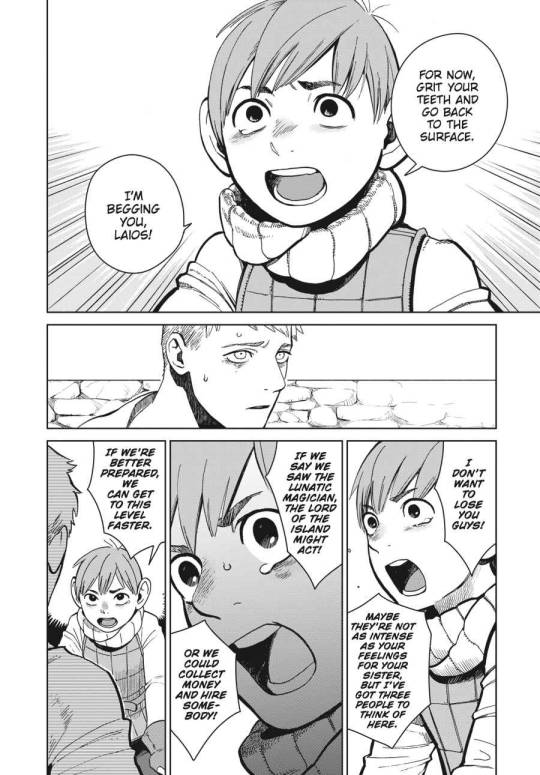
Chilchuck analysis speedrun: As a hardworking half-foot who grew up poor and discriminated against and had his gullibility taken advantage of multiple times in his early adventuring days, Chilchuck thinks optimism is a dangerous flaw. He’s stressed and strict all the time because his job is noticing details like traps that could get everyone killed before anyone knows it, he takes the lives of everyone to be on his shoulders, and with the way he speaks about it that probably partly reflects how he felt about taking it upon himself to provide for his family too. His life’s always been pretty centered around work and has become even moreso now that his wife left and everyone is independent, and due to past events he’s very iffy with bonding with coworkers. He thinks feelings and job are a disaster mix. Like with his wife or with parties hiring him as sacrifice, being open or having good faith is vulnerability which can get you hurt, so he processes and shows all his stress as anger instead of worry. Doing strict dieting probably isn’t helping the irritability what with hunger, and on top of being a hunger suppressant alcohol might be the main stress reliever he has.
His grey hairs are so earned
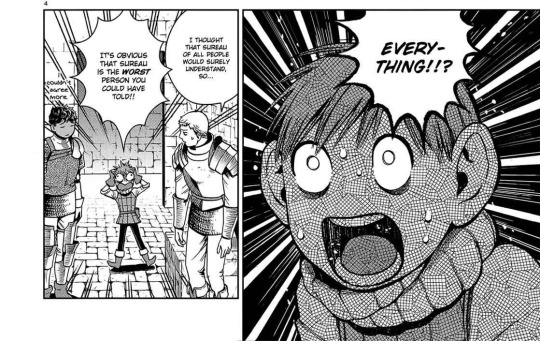

#Chilchuck tims#dungeon meshi#analysis#HAPPY CHILCHUCK DAY#You know what yeah understandable have a good day#Alcohol be a ticket straight to chilling out town I suppose#Spoilers#dungeon meshi manga spoilers#Thinking on if I should split my family masterpost into diff posts for max reach hmm#Anyways I’m def editing in the second page into that post that “I’ve got three people to think of here” sounds sooo much like that’s#How he’d think about it in a family setting as well. He works so hard for them 🥺#I could have put 100 pics on this post to justify everything I mentioned but this is a speedrun for a reason. I’m planning so many#Compilations rn i need a break from rereading lol#He’s just here to do his work!! He just wanna do his work!!!#I’m always rotating him in my brain like rotisserie chicken :( Hopefully this doesn’t sound disjointed or insane to average readers#He’s always on his guard so he has a short fuse and his type of humor & liking for snarky remarks doesn’t help#Also bc he knows nothing lasts he has a very work hard play hard mentality where ‘dying doing something you love. Like drinking’#Is nice in his opinion#This post makes it all sound so dry. Chilchuck is so messy thinking about him is thrilling I swear. This is concise but at what cost…#OH ALSO he has weird self-hate issues where he really values his skills but devalues himself on a personal level.#‘I am a coward. I only care about myself. I cheated on my wife (lying for no reason)’ etc etc#Can’t disappoint people and make them leave you if they already have no expectations and esteem of you 😏💡
473 notes
·
View notes
Text
More in depth analysis about the Spy x Family Manga Cover Chairs and Bonus Artworks (Or me just overthinking Endo’s decisions in everything and as always long post, please bear with me)
So I wanted to talk about something that I noticed about the various designer chairs that is featured on all manga covers.
Endo did say that he thought about how each chair matches the personality of the character, regarding it’s style, design or the color.
But I like to talk about something different about the chairs-it’s size or the seating capacity and how it reflects the characters relationship with others or their views about relationships. Also, I’m going to share something significant about the comedic bonus arts that also feature the chairs.
This focus mainly about Loid, Yor and Anya‘s Chair (including Fiona’s Chair) and the bonus illustrations that came with it.
Volume 1-Loid’s Chair: Le Corbusier LC2

There are two versions of this chair in the manga/anime, the love seat and the one seater. Loid is seated in the one seater chair in this cover, it means no one can sit there with him that reflects how reluctant he was in letting other people in his life. He wasn’t open for relationships (You can notice that those who are like him, intelligence assets; Franky, Fiona, Handler all sit in one seating capacity chair).

The bonus artwork was Anya sitting on the chair copying his pose. She’s the most fitting person to be in this seat because she can see through Loid’s mind, she basically knows who he really is and she likes him for that. Anya was fond of spies and she was excited about being part of his mission.
Volume 2-Anya’s Chair: Marshmallow Sofa
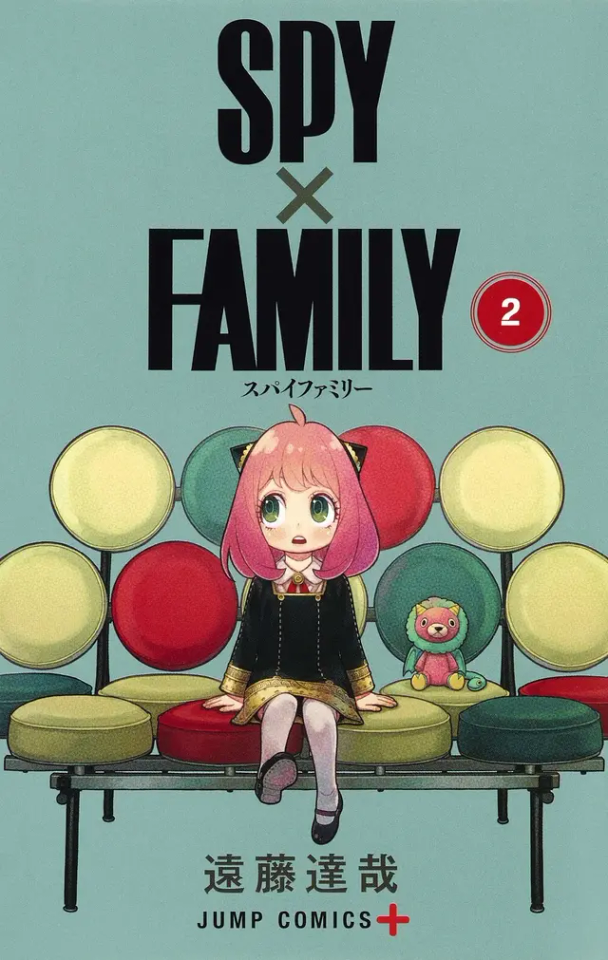
Anya’s chair has a large seating capacity and she was sitting at the middle, waiting for the empty spots on her both sides to be occupied. This depicts Anya’s anticipation for forming relationship with other people, about her wanting parents, a family, to be there for her.
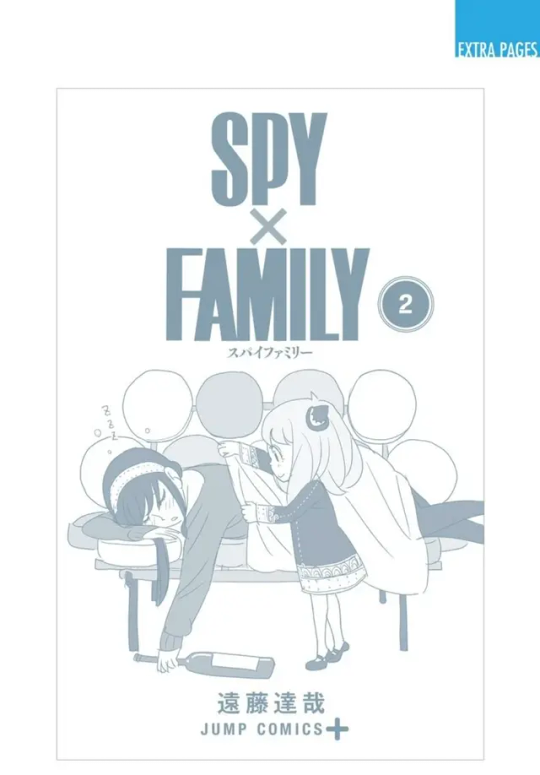
The bonus artwork was drunk Yor lying face flat on Anya’s chair. This artwork, for me, reflects Yor’s unwavering affection for Anya and Anya’s appreciation of Yor. Even drunk, she’s determined to protect her, as if she was her real daughter as seen during the castle chapter. She is fond of Anya.
Volume 3-Yor’s Chair: La Chaise (Featuring Fiona’s Heart Cone Chair)
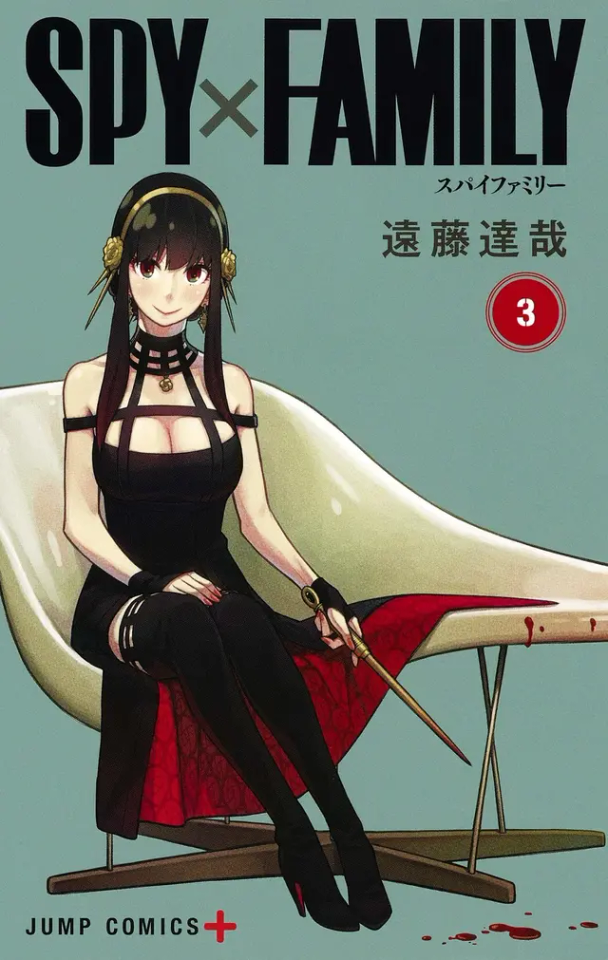
This is the chair I wanted to talk about and I have to use Fiona’s Chair for this analysis for Endo said that Fiona is designed to be Yor’s contrast and we can clearly see it in their chairs.
The seating capacity of Yor and Fiona’s chair greatly differ. Yor’s chair was big, Endo pointed how it didn’t even fit the cover, and even though Fiona’s chair is big too, she’s the only person who could sit in it. Other people can fit Yor’s chair but not with Fiona. I analyze this as Yor being open to genuine relationships and selfless while Fiona being closed off and selfish.
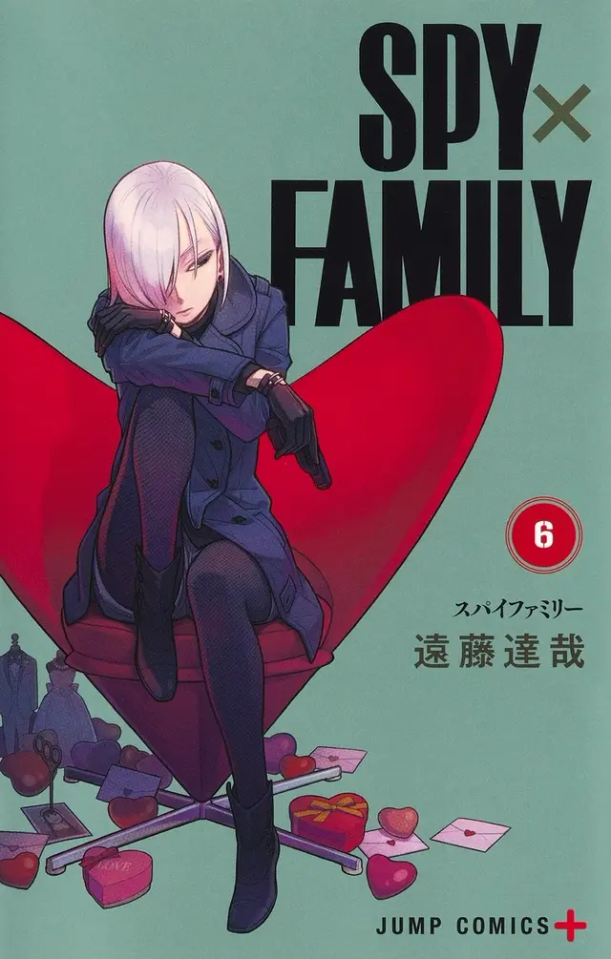
We know Yor’s motivation for being an assassin was for Yuri, for the sake of other people, and what is Fiona’s motivation? Clearly it was mainly for Twilight to marry her, love her and it was evidently show with all that stuff hiding behind her chair. I’m sure she experienced a lot of traumatic stuff that led to her being a spy but I don’t see other praise worthy and selfless motivations from her that was aside Twilight’s affection. Don’t get me wrong, she’s an interesting character and she isn't a bad person but I’m not really a fan of her personality just like I don’t like Yuri’s obsession with her sister.
In Yor however, she has nothing under or behind her chair. Just that blood that wasn’t even behind or below her chair. She wasn’t faking anything about her personality. It’s true that she accepted her marriage to preserve her assassin job but she genuinely wanted to marry Loid because he was the one who acknowledged her selflessness and that was enough for her to completely entrust her life to him. She welcomed Loid and Anya to her life because her longing for a companion to share her life with is as big as the size of her chair.
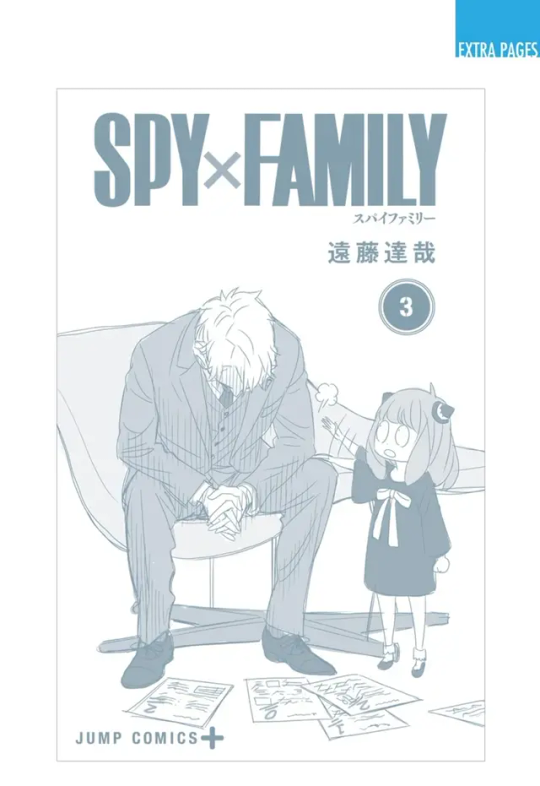
The bonus art in Volume 3 was Loid sitting on her chair. Despite the comedic set up of these illustrations, I think the people who tend to sit on the chair on the bonus arts were the ones who gets the person on the cover the most.
That is why Anya is in Loid’s (Because she can read his mind) Why Yor is in Anya's (Because Yor lost her parents at a young age too and she knows how to care for Anya because she did that to Yuri) and why Loid is in Yor’s chair (Because Loid understood her self sacrifice because he too, is the same as her) Also why Anya and Bond are in the bonus of Volume 4 because the two of them get each other, being both experimented on.
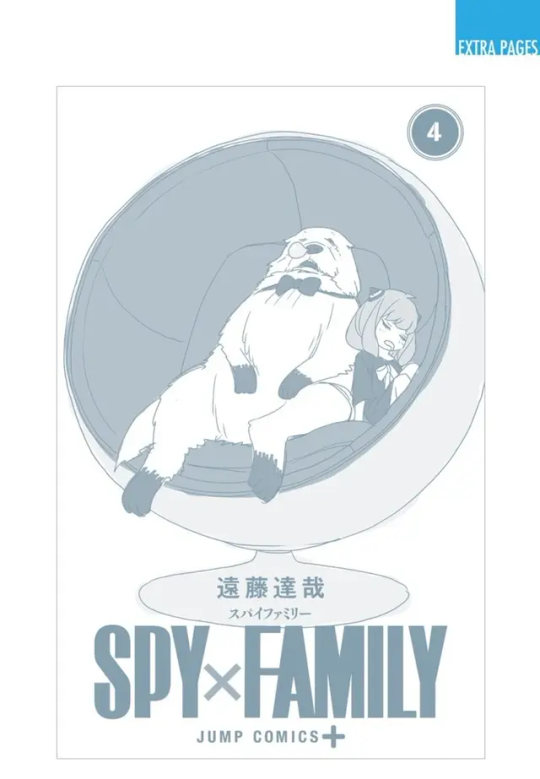
I also have some analysis about Volume 5-12 and the bonus artworks as well, but I might post them in another time since I haven't seen the translated bonus artworks in Becky and Emile and Ewen's Volumes.
But let me know if this analysis makes sense to you.
#spy x family#spy x family manga#anya forger#loid forger#yor forger#twilight#twiyor#spy x family anime#sxf anime#sxf manga#sxf thoughts#sxf analysis#The chairs are really playing significant roles in their character#Endo must've spent a lot of time thinking about it#Everything about the chairs just fits them#I'm excited to see who's going to be on Volume 13's cover#But my hunch would be either Henderson or we will repeat a character
503 notes
·
View notes
Text
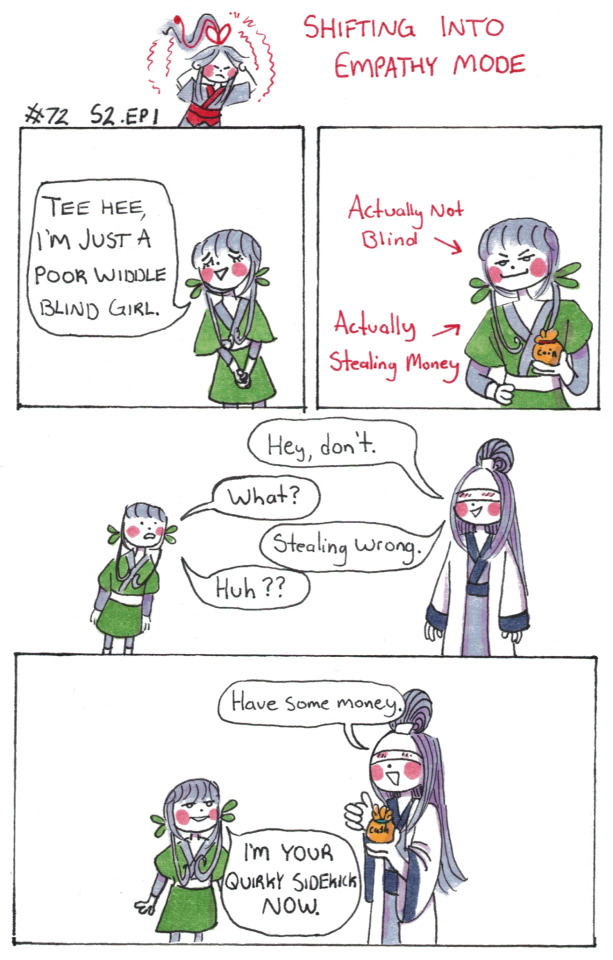
You're mine now, old man.
[First] Prev <–-> Next
#poorly drawn mdzs#mdzs#wei wuxian#a-qing#xiao xingchen#A-qing's story kicks off so strong. You really get a sense that she feels strongly attached to xxc during the pre-empathy scenes#and that she has a strong sense of loyalty and perseverance with strong survival instinct#but then you see her before all the tragedy and you *immediately* learn she is a clever trickster!#She follows xxc not out of gratitude but out of a sense that this guy is her meal ticket.#xxc is kind and strong but most importantly *noble*#she can smell the self-sacrificing bright eyed hope on this stranger. She knows the mere fact she's a young blind girl means#he will protect her. The fact he gives her a little money doesn't hurt her justification but tbh she would have followed all the same#a-qing is *the* catgirl of all time actually. Follows you for the fact you provide food and shelter. Opportunistic. May grow to be loyal.#That's not even getting into the parallels here between these two characters and wwx (who is seeing these events play out)#the yi city trio are arguably the three split aspects of wwx: who he feels like (a-qing the opportunist) who he wants to be (xxc the noble)#and who he feels seen as (xy the vengeful).#one day I'll write a more robust analysis on that. prob in the tags though#(His a-qing parallels are also tied with the fact they both were street rat orphans who learned how to code-switch to be whoever#they need to be to feel safe. I have a lot more thoughts to share but augh another time...another time)
1K notes
·
View notes
Text
OKAY who wants to hear about why i think nimona challenges amatonormativity? you do! 🫵
one of the main ways this is accomplished is through ballister and ambrosius’s relationship. it’s arguable that it doesn’t necessarily fit the traditional model of romance - not only are they a queer interracial couple, and not only is their relationship ambiguous in the book, but there are certain instances, especially in the movie, that subvert traditional ideas of romance and friendship.
one instance that really stands out to me is when the director asks ambrosius what’s on his mind and he goes on his imagined rant about how arm-chopping isn’t a love language - you know the one. when he mentions ballister, he refers to him as “the man i love, my best friend.” and not just one or the other, but both! the man i love, and my best friend. he places equal emphasis on both the romantic and platonic aspects of the relationship, valuing ballister in both a romantic context and a platonic context without treating either one as more important than the other.
and even moments such as the first “i love you” and the kiss manage to subvert tradition. both of these things are generally seen as a pretty big deal, especially in fiction - if the characters are kissing or saying “i love you,” it’s usually a moment in which everything changes. a line is drawn, dividing the story into after and now. sometimes it’s dramatic and climactic, with fireworks and a swell of music, but even when it isn’t it’s still seen as a turning point of sorts. now it’s official, now it’s real. but this isn’t the case in nimona. both moments are certainly significant - they do a good job of showcasing the character development and where ballister and ambrosius are on their respective journeys, and are certainly important in terms of representation - but neither one follows the path that most fictional romance does.
another way in which nimona challenges amatonormativity would be the emphasis on friendship! in the tavern scene (in the movie) when ambrosius suggests killing nimona, ballister disagrees and says “she’s my friend.” ambrosius replies with “aren’t i more than that?”, implying he’s more important than a friend - thus upholding amatonormative ideas. ballister becomes angry at that and leaves - challenging this idea and prioritizing his platonic relationship with nimona over his romantic one with ambrosius, as nimona is the one he wants to defend.
additionally, a big part of this scene is the way ballister deliberately rejects institute values while ambrosius unintentionally upholds them. and because the story challenges homophobia and transphobia (and other forms of bigotry) through the lens of the institute, it would make sense for it to challenge amatonormativity too! it’s something that’s become incredibly normalized, to the point that lots of people don’t even know it exists, and this is reminiscent of the institute brainwashing, especially when it comes to ambrosius - he’s been manipulated his whole life and probably genuinely doesn’t understand the level to which he’s internalized institute beliefs.
ballister prioritizes nimona many times, actually. when he tells ambrosius she’s “smart, kind, and quite sophisticated,” when he’s overjoyed to see her again at the end, when he refuses to kill her and saves her instead. over and over, he proves how much he cares about her, even when this involves directly going against what ambrosius wants - which, of course, is really what the institute wants. a core tenant of amatonormativity is the false notion that romantic relationships are more important or valuable than other types of relationships, but ballister actively goes against this!
to conclude, as a story that at its core is about identity and challenging societal beliefs, nimona defies expectations and traditional ideas of what it should or shouldn’t be. it’s possible that amatonormativity wasn’t what the creators had in mind, but the story still manages to challenge it with grace and elegance. just like its main character, nimona refuses to conform to what others want it to be.
#nimona#nimona movie#ballister blackheart#ballister boldheart#ambrosius goldenloin#ballister x ambrosius#ambrosius x ballister#nimona netflix#nd stevenson#nimona spoilers#i could go on tbh but i think this is a digestible amount#often when i’m writing a meta i’ll walk around in circles talking into my phone recording my thoughts out loud#and then i’ll play it back and put the most coherent stuff into a list which eventually becomes paragraphs#and the combined recordings for this one are about half an hour in total lol#i’m just. absolutely in love with the whole story. both the book and the movie mean so incredibly much to me#changed my life shaped me as a person etc etc :’)#OH i almost forgot. this analysis is dedicated to the person who sent me aphobic anon hate about it before it even existed lol#i know i said i wouldn’t post anything if people couldn’t be normal but idc actually. seethe with rage! <3#my words#meta
939 notes
·
View notes
Text
Damn, the Ember Island Players were actually kind of radical, weren't they? The more I think about it, the more it feels like the only way it makes sense in-universe is if being Fire Nation propaganda wasn't the point of their play at all. Aside from a barely tacked on ending where Ozai kills Aang, the play is remarkably sympathetic to the Avatar and a bunch of enemies of the Fire Nation, even framing them as being heroes. Even at points in the story where theyre literally killing Fire Nation soldiers, the narrative still seems to be on their side; they're the underdogs, the relatable ones. Its true that the Fire Nation values strength, but still, you'd expect that in a propaganda play they would be portrayed as at least a little bit more sympathetic... And sure, to some extent the gaang's characters could be seen as defamatory caricutures (the slander on Iroh specifically was probably intentional), but that also might be due to the Players getting a lot of their information from the cabbage man, someone who actively hates the gaang and only ever really sees the worst of them. (And notably, that also means that the Players had worked with an Earth Kingdom merchant to produce the play.)
Mocking the gaang is also just clearly not the point of the play or what people are there for. Sokka's actor says that he's constantly being approached by fans; people genuinely love these characters. The gaang have built entire dedicated fanbases in the Fire Nation because of this play. Honestly, the fact that they're on a remote island is probably the only reason they're able to perform the play the way it is. I imagine it would get shut down pretty quickly on the mainland. Considering all the propaganda in the Fire Nation that we've seen so far, I wouldn't be surprised if the ending was only written that way because it's illegal to write a story where the Fire Lord doesnt win. The play reads less like propaganda and more like 'we're doing the bare minimum to get this story past the censors.'
I'm really curious about what it's like behind the scenes for the Ember Island Players. Are their shows just simple, shlocky entertainment, or could they also be deliberate political commentary? With no recording technology, a play is easier to slip under the radar than something like a book: it's impermanent, stays in one theatre, and performances can be easily tweaked if, say, Fire Nation royalty happens to come by. It's interesting to me that Ursa seemed to like them, while young Zuko had a disdain for them, saying they 'butchered' the story of Love Amongst the Dragons; in all likelihood the version of the story Zuko grew up with in the palace was heavily propaganda-filtered itself. Although, to be fair, they're arguably just not very good playwrights. When it comes to the characterization, I do think some of it only seems bad because we know what the actual characters are like, but a lot of it is just bad writing clearly meant for cheap entertainment. For example, they sexualize Katara quite a bit (and there's other, better analysis out there I've seen that examines how they fetishize her as a Water Tribe girl). And, of course, all of the characters are reduced to shallow and stereotypical comedy.
Still, I think they're worth commending for doing their research and telling a story about enemies of the state that's both sympathetic and surprisingly accurate to actual events, if not the characters' personalities, amidst the Fire Nation's rampant propaganda and misinformation. From the little amount of information about them we can extract from the show, they seem like honestly very interesting people. They're walking this tightrope line between being very close to the heart of the Fire Nation but also separate from it; between being cheap, inconsequential entertainment and being a source of actual news for Ember Island citizens; between telling the underdog story about a ragtag group of children and still trying to make it look like Fire Nation propaganda. I'm not trying to make any big argument on whether they were 'actually good people' or whatever, I just want to know more about them. I kind of wish we could see their production of Love Amongst the Dragons now...maybe I'll write something about them someday
#I wrote this in a haze after randomly catching the episode while my sister was watching it#I'm so fascinated by the inner lives of these people. What does it look like to write and produce these plays?#What does their day-to-day look like? How do the actors feel about their characters?#Actually if anyone has any fanfic recommendations in this vein please tell me#atla#avatar the last airbender#ember island players#the ember island players#atla analysis#zuko#uncle iroh#katara#ursa atla#cabbage man#cabbage merchant#fire nation
228 notes
·
View notes
Text
Play: Kill the Old Torture Their Young

Playwright: David Harrower
Genre: Tragicomedy
Date Published: 1998
Original Language: English
Date Read: 11/26/22
Themes to Investigate: birds / birdwatching, "why?", autonomy, isolation, alienation, memory
------ below this line may contain spoilers ------
Quotes:
"Woman: We no longer know why we act." (Repeated later by Robert)
"Robert: I can only be where I choose to be. I have to accept it."
"Robert: The only thing they care about — the only reason they look at anything is to make sure it hasn't changed since the last time they looked. Because if it changes they're lost."
Notes:
Gouranga - potentially a Hare Krishna mantra meaning "Be Happy" and/or the name of a divine being, apparently popularly spray painted on bridges in the UK
coming back versus returning
being a name versus being a face
characters seem to know what they do, but struggle to conceptualize who they are / what they want
I've yet to understand the title
Multiple characters assume Paul & Angela know each other well. Angela and Paul both invest in and resist a relationship with one another, but in the end it seems they return to acquaintances
0 notes
Text
Styx, Fae, and Malleus—Oh my!
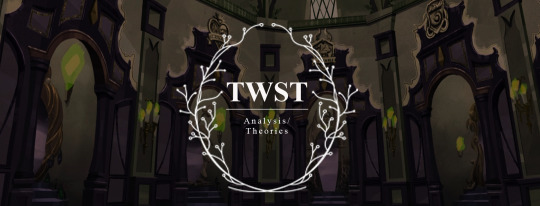
Okay I'm writing this more as a marker for myself because I keep breaking my brain with connecting C6 to C7, but I've included my notes down below to kind of trail through how things might go with the next C7 update. Since the Shroud brothers are back in business, we'll be seeing a lot more of Styx's hand too, so I also wanted to collect as much information (canon) as I can on them too. Because I just think they're neat, and combining all the information makes them that much neater!
Warning for a long-ish post.
All About Styx (Up to C7, April 2024)
Styx, originally serving as just the Watchman before the Age of Gods (which Malleus discusses in C6 part 18),

is an independently operating institution (non-government affiliated) that specifically focuses on research pertaining to blot. According to the welcome video narrated by Idia’s mother and father, Styx covers the following:
Safe use of technomantic technology
Magical power analysis
Preservation of ruins and mage stones
Blot emission reduction
Post OB treatment
Magical disaster prediction systems
Maintaining phantom databases
Styx operates off of the Isle of Woe, an area mostly inaccessible to outsiders due to its status as being below the ocean and only accessible via the Oceanus Gate. Styx is seemingly composed of multiple units and teams, including the Hex Team, with most of the employees living in the residential block of Oceanus and using chariots (technomantic vehicles) to get to the tower. Another unit that Styx controls are the Charon members. These appear to be the equivalent of armed forces under Styx’s command. They specifically act as retrievers of over blotted mages, or more specifically the phantoms involved in the overblot. Magic Marshals and the Arcane Response Unit often handle overblot cases, but in extreme incidents, Charon members step in.
It’s mentioned that they also arrive regardless of if they have authorization from the government of the location the overblot is occurring.
Regarding the technomantic equipment mentioned, this is what Styx seems to mainly use for all operations, likely due to the nature of its research. Technomantic technology has an ability to almost entirely nullify magic. Although not 100% effective, it was enough to even make Rooks UM limited, forcing him to only track the kidnapped students when there were second breaks in the tech. This tech was also used on the overblot students, with Riddle stating that it’s equivalent to his UM (C6 part 26).
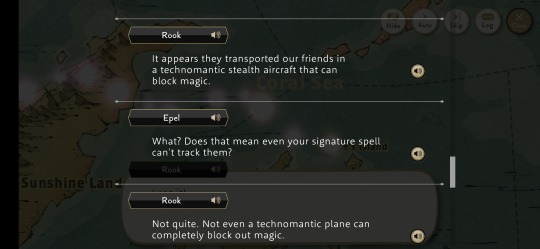
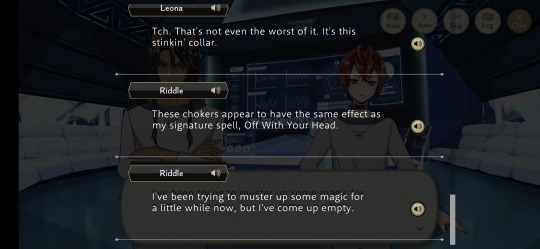
The tower that Styx operates out of is a large structure located in the centre of the ancient city that was originally attached to the Kingdom of Heroes. Within this tower, Styx keeps phantoms preserved frozen in the lower layers. This area is referred to as Tartarus and hosts approximately 10,000 subjects split into 12 levels. A-class are considered exceedingly dangerous phantoms, according to Ortho. Sector 12 is where the original Phantoms are housed, known as the ‘Titans’. These are three phantoms that have been sealed in Tartarus by the original Jupiter family members since the Age of Gods.
The system designed to preserve these phantoms is known as the Cerberus System. This encapsulates the entire Isle, not just Styx. According to Idia, mages are taken and housed for testing in this region before being wiped by Lethe, another system operated by Styx that re-wires memories and implants false ones. Interestingly, Lethe works differently on fae than humans due to fae’s long lifespans. Idia states that it’s hard to adjust what information to remove and rewrite without making it obvious that there was an erasure. He does mention Malleus by name when discussing this, but not Lilia.
All About The Fae in Briar Valley (Up to April 2024, JP Spoilers)
Fae appear to live broadly across Twisted Wonderland, but a large majority do reside in Briar Valley (other additions such as Fairyland/Land of Fairy have been mentioned and seem to host diurnal fae. More of this can be found in the fairy gala events. Diurnal fae are considered to herald the coming of spring with this gala, which ties in with later discussions about fae and nature). Various species were also noted to exist, including:
Dragon fae (note: Dragons are mentioned to have arrived for Meleanor during her youth, however after her passing a decade later it appears that Dragons have either gone underground or extinct across the broader Twisted Wonderland area)
Raven fae
Bat fae
Crocodile fae
Subcategories of crafter fae and the likes exist too, but don’t quite count as species
There appears to be a hierarchy of value among fae. In one conversation by a Senate member (in Chapter 7, release 6), Lilia is referred to in derogatory terms due to his status as a bat fae. It is unknown if this bias is strictly the Senate member, Briar Valley, or if it spreads across broader fae populations. Fae also appear to have monarchies, although the only two known so far are the Queen of Fairyland and the Draconia Family. Fae also appear to age at different rates (Malleus states infant fae often take 30 years to walk, and it took him 20 years alone to gain his 2-legged form).
Due to Briar Valley being the major focus of C7, we’ll look at fae in this region specifically.
For context, constant conflict has arisen between fae and humans, specifically within Briar Valley. A major conflict and large plot point in C7 so far is the conflict between Briar Nation (former name of Briar Valley) and the Silver owls. The Silver Owls, run by Henrik, carried out mining operations throughout Briar Nation without permission from the royal family. Despite the name Silver Owls, it should be noted that they are also called Iron Ones due to their iron weapons and armor. According to Briar Nation soldiers, Silver Owls recklessly endangered fae by driving wildlife into villages in addition to colonizing the region. The Silver Owls (Henrik in particular) are aiming to attain Princess Glow. Henrik stated that he wanted it for his father (unlikely, lbr). Princess Glow appeared to be a gem associated with the Draconia Family that was capable of performing miracles like healing incurable ailments. It’s unknown if this is factual or not, but Meleanor does appear to put value on the gem when discussing it with Lilia.
Conflict with the Silver Owls extended across several regions in Briar Nation, including:
Verdant Moors (outside the present day borders—confirmed by Sebek in C7)
Canyon of Howling Winds (also called Valley of Howling winds in some translations)
Mystical Mountain/Forbidden Mountain
Thunderclap Mountains
Cape Sunrise
Tenebrae Forest/Dark Night Forest
Crimson plain
Dragon’s Tail Mountains
Wild Rose Palace
Black Scale Palace
Dragon Capital City (surrounding Black Scale Palace)
Cradle Tower
Note: present day Briar Valley is situated farther up north and is said to have a cold climate for the most part, including particularly harsh winters (confirmed by Silver in release 4 of C7). Double note: Names may be susceptible to change with EN release.
The conflict ended with Meleanor and Levan (Malleus’ parents) allegedly dead. Fae ceased intermingling with humans likely after this conflict according to Lilia in C6 part 18, leaving to heavy deficits in the validity of history surrounding the fae. This also means that a lot of human history books miss history that fae may have personally experienced or have to share (as spoken by Trein and Lilia).
In terms of powers, fae in Twisted Wonderland seem to rely on nature a great deal for their magical abilities. Idia’s father discusses the extent of what some fae can do due to their connection with ancient magic, including mentioning how fae have had control over climate change and diastrophism since the Age of Myths (presumably predating the Age of Gods). Malleus’ ability to alter the world in a designated area falls under this category. He is stated to have magic tied to the earth itself. Idia’s mother also mentions that fae can also draw magical energy from nature itself, building on Idia’s fathers statement about how fae’s magic directly connects to the earth. Generally, fae with elemental connections can do this, which proposes the idea that Malleus has such an ability.
It also appears that fae can lend this magic to humans. The Knight of Dawn frequently calls upon the blessings of diurnal fae to aid him in his fights throughout C7 (note: he says 'fairy guardians', so this could be just this specific instance).
So… what’s up with chapter 7, as of April 2024? (JP Spoilers)
Well… Malleus over blotted. Inconvenient, absolutely. Fortunately, his grandmother snitched and gave all of his information over to Styx, allowing them to formulate somewhat of a plan to use.
We know specifically that the Arcane Response Unit is unable to get access to Malleus through the thorns because, should the thorn wall be penetrated or collapse, it will kill whoever is caught inside of it. At the moment, ARU is likely on the borders of Malleus’ thorn wall while Ortho (acting as a stand-in Charon member, in this case) deals with the issue. Anyone who gets too close to the thorns (fae or human) are also being sucked into the barrier.
Silver, Sebek, Yuu and Grim are currently travelling through various dreams. This allowed some insight on fae (see Fae in Briar Valley for more) as well as the abilities that they possess. Ortho has pulled the group into Idia’s dream, stating that Malleus is using all resources to keep Lilia asleep. Ortho was able to penetrate into the barrier using a counter-spell barrier and ethereal slicers, in addition to a magical cannon honed by Styx.
We also know it’s confirmed that Malleus needs to either voluntarily end his spell or die in order to actually cause the barriers to drop.
What might happen, then? (JP Spoilers)
Who knows! Yana likes to keep us on our toes. That being said, one of the biggest takeaways that came from this is the technology (technomantic) that Styx has access to, as well as what fae seem to rely on to continually use their magic. Styx’s access to technology that can almost entirely nullify magic in combination with their isolation from ‘nature’ (based on the brutalism architecture their facility had) could be two avenues of mitigating Malleus enough to at least let the students get an upper hand.
However, Styx also did confirm that their technomantic equipment was not having as good of an effect on Malleus’ barrier as they anticipated. If technomantic equipment were to be used on Malleus, it would need to be something advanced, like Ortho’s Cerberus gear, but on a larger scale. Ortho has already shown that Malleus’ magic is ineffective when faced with the type of tech that Ortho is equipped with, positing the idea that this can be an avenue to take. In the battle with Ortho, Malleus does appear to freeze up and misses a hit.
The comment about Malleus needing to break the spell himself was emphasized a lot in this section. Styx confirmed they’ll reach out to Queen Maleficia to see if she can persuade Malleus to drop the spell, but they’re also convincing the dreamers to persuade Malleus as well.
So… it seems like a triple whammy of tech, Maleficia, and guilt tripping as a way to take Malleus down. Exciting!!
#twisted wonderland#twst#twst analysis#idia shroud#ortho shroud#malleus draconia#lilia vanrouge#twst silver#sebek zigvolt#idia's parents#twst spoilers#maleficia draconia#meleanor draconia#levan draconia#listen i just love styx and the fae lore that's been dropped and i'm eating it#i couldnt get my hands on fairy gala so if anyone has info on her... plz add#i spent 7 hours playing twst for these facts plz
155 notes
·
View notes
Text
the jaidens on the can you hear it mini-event and we all know ab their chat shenanigans



but like. how about this one. (after the dungeon crawl, when they're at the ordo discussing theories)

they're so silly.... their friendship means so much to me
#the jaidens#qsmp#ramblings#qsmp jaiden#qsmp badboyhalo#qsmp cellbit#qsmp foolish#i am incredibly emotionally attached to the sheer potential of this group and their combined goofiness and their dynamics and-#yes i have issues shut up#fun fact! im also actively avoiding anything and everything chess related on the server (eg when they play chess games)#this is beacuse i know i will scream about it#is it because of the play styles and thus analysis or because of rage? well. depends#(poor portrayal of chess in media is this user's most prominent pet peeve)#but back to the jaidens i love them so fucking much there needs to be more about them as a group im sobbBIing#sun qsmp posting
786 notes
·
View notes
Text
Ushijima-Oikawa parallels with Kageyama-Hinata
To me, Ushijima and Oikawa are like a tragic parallel to Hinata and Kageyama. If Oikawa had gone to Shiratorizawa then he and Ushijima could've had the partnership that Kagehina had. But because he didn't, they will never know what it's like to make the other feel invincible.
Shipping goggles aside, the parallels have to be intentional (haikyuu is too well-written for it to be just a coincidence): Both Ushijima and Kageyama were framed as naturally gifted volleyball monsters. Meanwhile Oikawa and Hinata believed that they were just average (even though the people around them know that they have their own strengths). Ushijima was the one who kept winning against Oikawa, just like how Kageyama was always ahead of Hinata. Both Hinata and Oikawa went abroad to gain experience so they could finally beat their rival. Ushijima and Kageyama are both awkward, intimidating, and ASD-coded while Hinata and Oikawa are framed as easy-going extroverted chatterboxes. These pairs are literally so similar it's crazy. Look at them and tell me it's not intentional
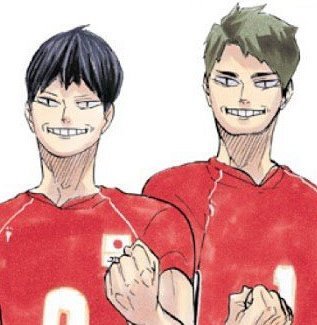

It also makes sense when you consider that their playstyles are also complementary. Kageyama and Hinata were a good match for each other because Hinata needed Kageyama's precision and Kageyama needed someone agile to match his own speed. But Ushijima's only requirement is for the ball to be set high and the right distance from the net so it's easy to hit. And which setter is known for dedicating themselves to their spikers, giving them easy sets? Oikawa. They truly could've been a terrifying duo.
I think Furudate was trying to show what Kageyama and Hinata could've been if they didn't team up. They'd still be strong, sure, but not invincible like they were in Karasuno. (as opposed to the Miya twins, who were supposed to show what they could've been like if they had an equal from the very beginning)
But in the end it all worked out for everyone! They all got to play on the world stage together. Ushijima and Oikawa even had their reconciliation at the all stars match (still waiting on the Oikawa-Kageyama reconciliation please please please 👀). They're all happy so I suppose it isn't actually tragic. I just cant help but wonder what could have been if Ushijima and Oikawa learned what it's like to be each other's greatest ally. Hinata and Kageyama were so lucky to have found each other after all.
#long story short i think kagehina and ushioi should go on a double date together#the shenanigans that ensue will be glorious#what if they play a 2v2 match: kagehina vs ushioi#it's also funny how ushijima has played on the same team as kageyama at least 4 times now and not once with oikawa#they are BESTIES your honor#sorry this has been in my drafts for a while and i just finished it now. yay vacation#haikyuu#haikyuu!!#kagehina#kghn#hq#ushijima wakatoshi#ushioi#oikawa tooru#kageyama tobio#hinata shoyo#hinata shoyou#my post#hq kageyama#hq hinata#hq ushijima#hq oikawa#hq analysis
184 notes
·
View notes